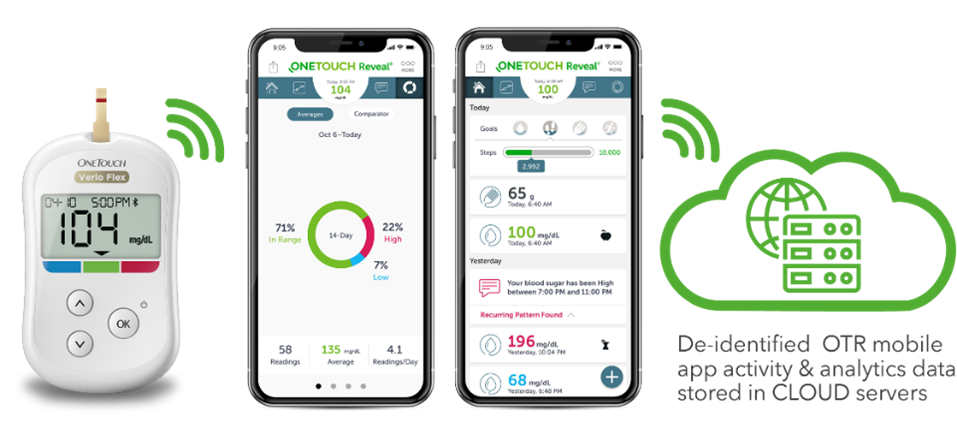Rumours of the demise of blood glucose monitoring are premature!
BY MIKE GRADY, HILARY CAMERON & ELIZABETH HOLT
©LifeScan
It may seem a provocative statement, but it seems to us that blood glucose monitoring (BGM), a technology that has taken care of the vast majority of people with diabetes for the past 40+ years, is being ushered to an untimely grave. The grim reaper behind this apparent demise has been the emergence, particularly over the last 5 years, of continuous glucose monitoring (CGM) systems, like those from Dexcom and the Freestyle Libre from Abbott, which have rightly taken centre stage as more convenient barometers of glucose levels.
So, are blood glucose meters toast? Before you answer, consider that according to the IDF, there are currently 537 million people with diabetes globally. That’s 1 in 10 of us. But according to data from JP Morgan, as reported by Close Concerns, CGM companies have around 7.5 million customers – so what technology might the other 530 million be using now and for the foreseeable future to measure glucose? This dilemma troubles us. As people who pour over the latest diabetes publications and join illustrious annual diabetes meetings, we find both outlets largely devoid of any mention of BGM. However, you will find increasing focus upon Social Determinants of Health in diabetes, which translates to concerns about access, poverty and inequality. The IDF says 3 out of 4 people with diabetes live in low- or middle-income countries. It seems a rather topsy-turvy world for leaders in diabetes to dismiss a technology like BGM, which, by its nature, provides a lifeline for the majority of people for whom CGM is out of reach. Yes, we know CGM may be the best solution for everyone, and soon…but we also don’t all currently drive electric cars, and for similar reasons.
Companies like LifeScan are bucking this trend and innovating for people using BGM. Did you know that in 2022, over 5.4 billion people had a mobile phone? OneTouch® Bluetooth® connected BGMs with a companion OneTouch Reveal® (OTR) mobile app put powerful diabetes management tools right in the phones in the hands of people with diabetes. The app shows glucose trends, provides insights, and allows people to share data directly to their nurse or doctor. One of our latest studies, published in JDST, explored the value of our app with the connected OneTouch Verio Flex® meter (See figure 1) in more than 144,000 people with diabetes. People obviously don’t want high or low glucose excursions, but our past research told us that people don’t always understand or act on the numbers on their meters – so we adopted a colour coded system that indicates when a number is above (red), within (green), or below (blue) a target range. Being in-range and taking action when out-of-range is a good thing, because, in the long run, if you have more of your readings in-range, it is more likely you can prevent or delay the onset of diabetes complications.
Figure 1 – The OneTouch Reveal® mobile app and OneTouch Verio Flex® meter
Our study found that people with type 2 diabetes who used our app and meter and engaged in a few as 1 to 2 app sessions per week increased the amount of readings in-range by 10.3 percentage points (See table). It was encouraging that the time spent in those 1 to 2 app sessions amounted to only about 10 minutes on average per week. That’s important. Any behaviour change that’s going to stick (and our duration was 6 months) needs to fit in with whatever people do in their daily lives. With diabetes, being consistent is much more impactful than having long gaps in diabetes management – nobody likes surprises.
Table – Data from our 2023 JDST publication showing improved readings in-range
One last thought we want to leave you with is that when using connected BGMs, you truly don’t need to manage diabetes on your own. Figure 2 shows how connections come to life with the OneTouch® ecosystem.
Figure 2 – Our ecosystem and connected BGMs keep people connected!
Remember, our JDST study collected glucose readings from people in the real-world. We don’t know who took care of our 144,000 people during those 6 months or how often they were seen, but we do know that with our connected BGM, everyone had the opportunity to send their data to someone who cares for them, and that’s something we are really trying to emphasize. We hope that whether you use BGM or CGM to manage your diabetes, you take advantage of sharing your journey with others. People are always there to help and encourage you.
Article Details
Improved Glycemic Control Using a Bluetooth®-Connected Blood Glucose Meter and a Mobile Diabetes App: Real-World Evidence From Over 144 000 People With Diabetes
Mike Grady, Hilary Cameron, Elizabeth Holt
First Published January 30, 2023 Research Article
DOI: 10.1177/19322968221148764
Journal of Diabetes Science and Technology
About the Authors







